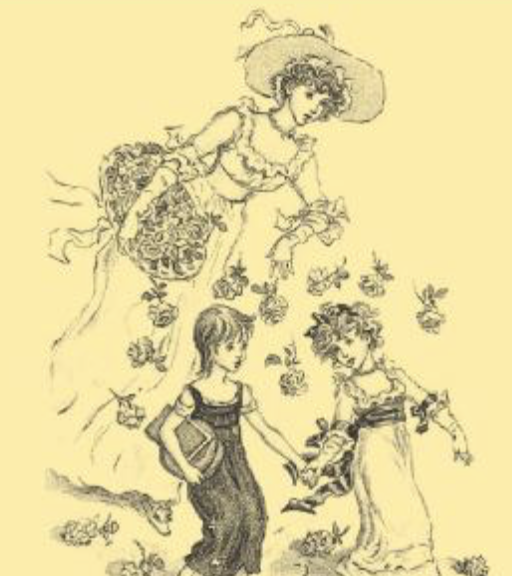
Strictures on the Modern System of Miss Thoughtless, Miss Milner and Miss Price’s Educations
Searching in the “time of Covid” for a scholarly edition to aid in situating within the scholarly conversation, of Hannah More’s time and now, her Strictures on the Modern System of Female Education: with a View of the Principles and Conduct Prevalent among Women of Rank and Fortune (1799), I landed upon a Cambridge Library Collection that my university does not have access to. Due to my status as scholar-in-training studying for qualifying exams, I assumed “Cambridge” would come with a critical introduction and footnotes, and comprise both volumes of it, and I was mistaken on both counts. So I read volume 2 in a purchased paperback, and volume 1 (and reread 2) as a Hathi Trust PDF on my tablet. The paperback gave me the feeling of reading an eighteenth-century text printed via 20th-century processes. I say 20th– not 21st-century processes due to the fact that it appears to be a mere image-of-each-page replica and not an OCR, digitized version.[1] The 1799 pagination appears to have been preserved and printed on larger, 20th-century standard-size sheets for a paperback—resulting in a hybrid reading experience.
After reading More’s Strictures, I see why scholars have not created a better, more critical and footnoted edition of this text—it’s not that feminist, and it’s not that sexy. It is a historically important work to understand especially within the context of Wollstonecraft’s feminism. “Jane Austen knew all about Hannah More,” Jane Nardin writes in Persuasions, “but Hannah More never heard of Jane Austen. Nor is this surprising. Though More’s popularity did not long survive her death in 1833 at the age of eighty-eight in her own time, this Christian moralist was, by a huge margin, England’s most famous woman writer” (15). Austen’s Mansfield Park, according to Nardin, “makes extensive use of the ideas” in More’s best-selling advice manual for parents.
Might this idea of Fanny Price’s Hannah More-brand of education help explain the “bitter struggle” between Fanny Price and Catherine Morland “to avoid the stigma of being labelled Jane Austen’s least appealing heroine” (Dix 85)? I think so. I think also, that this idea also links other non-popular, not-so-fun “conduct book” heroines such as Haywood’s (boring) Harriot/foil to Miss Betsy and Inchbald’s similarly lukewarm (if that) Matilda compared with her mother, Miss Milner/Lady Elmwood. Inchbald ended her Simple Story (1791) with an all-caps warning to parents: “so that [Mr. Milner, Matilda’s Grandfather] had given to his daughter A PROPER EDUCATION. The novel leaves up for debate what was the proper education, Mr. Milner’s daughter’s—kept separate from Catholics due to her protestant mother—or “his” granddaughter’s—raised by a Catholic mother and neglected until ready-for-marriage, by her father. However, part I concerning the seduction of a priest is much more engaging than part II concerning Matilda and her marriage to a man she does not love nor feel passion for. The conduct-book heroines of Haywood’s Betsy Thoughtless, Inchbald’s Simple Story, and Austen’s Mansfield Park (and to a less extent, Northanger Abbey) echo More’s Strictures. Scholars seem less apt to teach Fanny Price than Elizabeth Bennett because we have this idea of Austen-as-feminist, which mold Fanny Price—and Hannah More—do not fit.
More writes that learning should “contribute to form the mind and enrich the judgment” through “books of solid instruction” (343) and that parents are responsible to form not only the mind, but also the character of their female children so that they practice the “religious use of time” (331). Sir Thomas Bertram educates, according to Nardin, his daughters in the ways that “More deplores”—thus aligning them, I would argue, with early Miss Betsy and late Miss Milner (Lady Elmwood) who, like the eldest Miss Bertram turned Rushworth, commits adultery.
Fanny does not acquire the same education as the Miss Bertrams due to her middle-class, semi-outsider status as she is continually reminded she is not one of them, not really. Instead, she learns Christian principles such as self-sacrifice through Edmund—“at great psychological cost” (Nardin 18). Readers who want to map Elizabeth Bennett and her wit onto Austen and all her heroines, then, are disappointed with, if they don’t actively harbor disdain for, Catherine Morland and Fanny Price. However, just as it is a feminist project to depict empowered heroines, so too it must entail the true picture of the disempowered heroine. Paintings require light as well as shadow, of which any “accomplished” heroine such as Austen’s Emma would become well aware. In this way, the novels of Haywood, Inchbald and Austen take principles such as those espoused by Hannah More as inputs and create outputs, feminist (and not).
Work Cited
Dix, Robin. “The Pleasures of Speculation: Scholarly Methodology in Eighteenth-Century Literary Studies.” British journal for eighteenth-century studies no. 23, 2000, pp. 85-103.
More, Hannah. Strictures on the Modern System of Female Education, in two volumes. Fifth edition. London: T. Cadell Jun. and W. Davies, in the Strand, 1799. https://hdl.handle.net/2027/nyp.33433075996433
—–. Cambridge UP, 2010.
Nardin, Jane. “Jane Austen, Hannah More, and the Novel of Education.” Persuasions, no. 20, 1998. http://jasna.org/publications/persuasions/no20/nardin/
[1] There is an Eighteenth-Century Collections Online Text Creation Partnership version digitized/OCR’d, but this does not provide a critical or pedagogical framework as would a Broadview paperback, for example.

